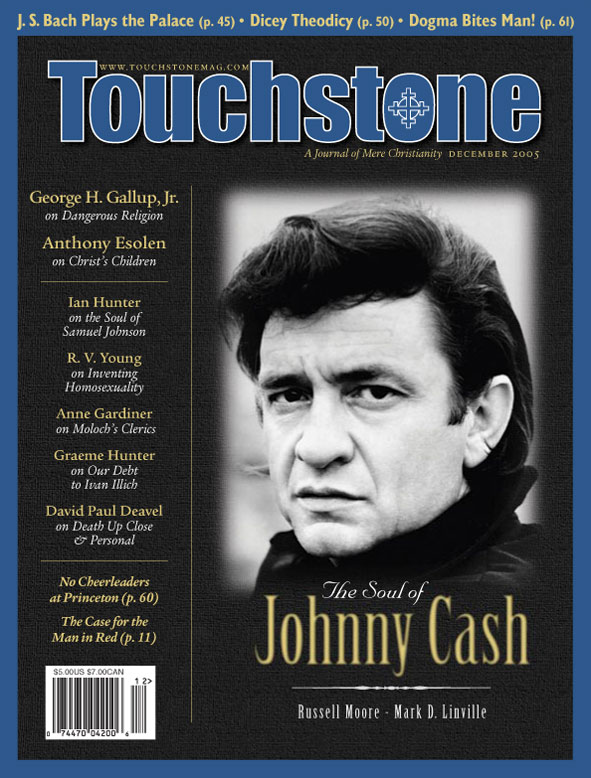Feature
The Gay Invention
Homosexuality Is a Linguistic as Well as a Moral Error by R. V. Young
For thousands of years, until the late 1800s, our ancestors were completely oblivious to the existence of a fundamentally distinct class of human beings. Indeed, during the long period of Greco-Roman antiquity and more than a millennium and a half of Christian civilization, man did not even have a name for this class.
Or so asserts an almost universal assumption fixed in the language almost everyone uses: that “heterosexuals” and “homosexuals” are two permanently and innately different kinds of human being, and that “sexual orientation” constitutes a difference comparable to the difference between male and female. Widespread acceptance of “homosexuality” and associated terms thus biases discussion of the subject before an argument is even formulated.
Terms Lacking
What might be called the philological evidence calls this notion into question. If it were true, someone would long ago have given this class a name. That no one did until very recently suggests that the notion is not true.
In the first footnote of the first chapter of Greek Homosexuality, which is generally regarded as the definitive treatment of its subject, Oxford classical scholar K. J. Dover points out that the ancient Greek language “has no nouns corresponding to the English nouns ‘a homosexual’ and ‘a heterosexual’.” Such an observation would seem to call for more notice than is accorded by a single short footnote, but even the apparent concession is misleading, insofar as it suggests that the absence of these terms is a peculiarity of Greek.
In fact, Latin also lacks these terms and the same is true of Old and Middle English. Among modern European languages the word that corresponds to the English “homosexual” is generally a variant on the same word: in Spanish homosexual and in Dutch homoseksueel, for example. German also offers gleichgeschlechtlich, which is simply a combination of two Germanic roots, gleich and Geschlecht, that correspond to the Greek (homo = same) and Latin (sexus = sex) of the English word.
This English word is itself a very recent coinage. According to the Oxford English Dictionary, both “homosexual” and “homosexuality” first appeared in English in 1892, along with “heterosexual” and “heterosexuality,” in an English translation of Richard von Kraft-Ebing’s Psychopathologia Sexualis (1886) and turn up again five years later in Havelock Ellis’s Studies in the Psychology of Sex.
In other words, only in the late nineteenth century, when physicians began discussing sexual perversion as a medical rather than a moral problem in Latin treatises intended only for the learned and required a neutral, clinical term, was there a perceived need to refer to “homosexuality.” Moreover, it is not at all clear that the originators of the term had precisely in mind what is usually meant by “homosexuality” in contemporary parlance.
Kraft-Ebing, for example, does not write a separate chapter on this subject (Ellis, however, does); same-sex attraction is rather an attribute or additional characteristic of other specific activities—regarded by Kraft-Ebing as abuses of the sexual organs and the pleasure associated with erotic stimulation. Ellis says that the term actually originated in 1869 with an obscure Hungarian doctor, Benkert (or Kertbeny), and endorses its use because “its significance—sexual attraction to the same sex—is fairly clear and definite, while it is free of any question-begging association of either favorable or unfavorable character.”
R. V. Young is Professor of English Emeritus at North Carolina State University, a former editor of Modern Age: A Quarterly Review, and the author of Shakespeare and the Idea of Western Civilization (Catholic University of America Press, 2022). He and his wife are parishioners at St. Ignatius of Antioch Church in Tarpon Springs, Florida. They have five grown children, fifteen grandchildren, and three great-grandchildren. He is a senior editor of Touchstone.
subscription options
Order
Print/Online Subscription

Get six issues (one year) of Touchstone PLUS full online access including pdf downloads for only $39.95. That's only $3.34 per month!
Order
Online Only
Subscription

Get a one-year full-access subscription to the Touchstone online archives for only $19.95. That's only $1.66 per month!
bulk subscriptions
Order Touchstone subscriptions in bulk and save $10 per sub! Each subscription includes 6 issues of Touchstone plus full online access to touchstonemag.com—including archives, videos, and pdf downloads of recent issues for only $29.95 each! Great for churches or study groups.
Transactions will be processed on a secure server.
more on sex from the online archives

28.2—March/April 2015
Man, Woman & the Mystery of Christ
An Evangelical Protestant Perspective by Russell D. Moore
more from the online archives

27.3—May/June 2014
Religious Freedom & Why It Matters
Working in the Spirit of John Leland by Robert P. George
calling all readers
Please Donate
"There are magazines worth reading but few worth saving . . . Touchstone is just such a magazine."
—Alice von Hildebrand
"Here we do not concede one square millimeter of territory to falsehood, folly, contemporary sentimentality, or fashion. We speak the truth, and let God be our judge. . . . Touchstone is the one committedly Christian conservative journal."
—Anthony Esolen, Touchstone senior editor











